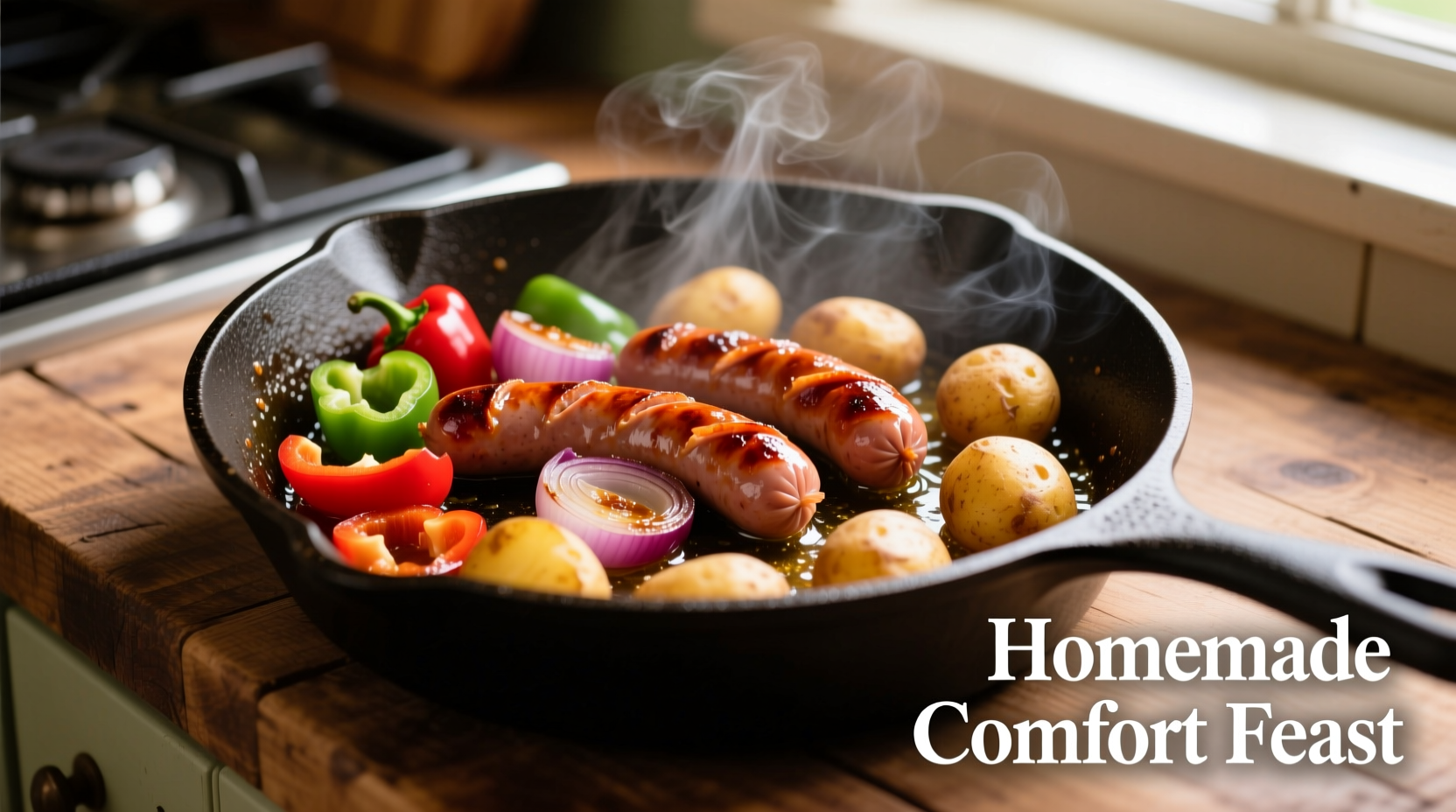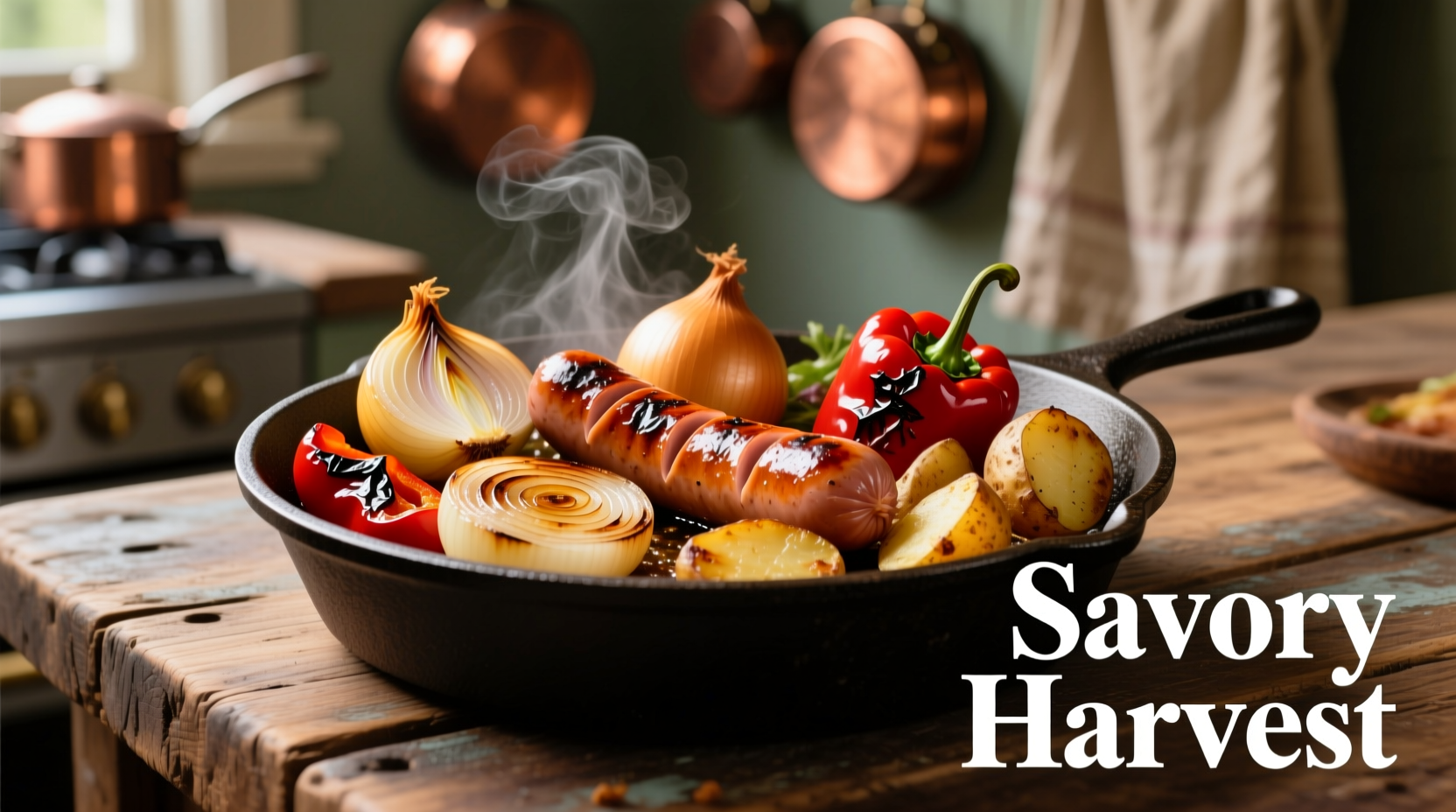The perfect combination of sausage, onion, peppers, and potatoes creates a hearty, flavorful one-pan meal that balances protein, savory notes, sweet peppers, and hearty starch. This classic ingredient pairing works because the sausage's fat renders down to perfectly crisp the potatoes while the onions and peppers caramelize, creating a harmonious blend of textures and flavors that requires minimal additional seasoning.
Why This Ingredient Quartet Creates Culinary Magic
When you combine sausage, onion, peppers, and potatoes in one dish, you're leveraging centuries of culinary wisdom. Professional kitchens consistently return to this combination because it creates a complete meal with balanced macronutrients and complementary flavor profiles. The sausage provides rich umami and fat that carries flavors, onions add sweetness when caramelized, peppers contribute bright acidity and texture variation, while potatoes serve as the perfect neutral starch that absorbs all these delicious elements.
Your Complete Cooking Roadmap
Follow this step-by-step journey from raw ingredients to finished dish, designed specifically for home cooks who want restaurant-quality results without professional equipment.
Planning Your Perfect Sausage & Veggie Feast
Before you start cooking, proper planning ensures success. This isn't just another sausage recipe—you're creating a balanced meal where each component shines without overwhelming the others.
| Ingredient | Selection Tips | Quantity for 4 Servings |
|---|---|---|
| Sausage | Choose firm varieties like kielbasa, chorizo, or Italian sausage | 1.5 lbs (680g) |
| Potatoes | Russet or Yukon Gold for best texture | 2 lbs (900g), 3/4" cubes |
| Onions | Yellow or sweet varieties for balanced sweetness | 2 medium, sliced |
| Peppers | Mix of bell peppers for color and flavor variation | 2 large, 1/2" strips |
According to USDA food safety guidelines, proper ingredient selection prevents cross-contamination risks. Always keep raw sausage separate from vegetables until ready to cook, and use separate cutting boards for meat and produce (USDA Food Safety and Inspection Service).
Preparation: Setting Yourself Up for Success
Professional chefs know that mise en place (everything in its place) separates good cooks from great ones. Follow this preparation sequence for optimal results:
- Prep potatoes first - Cut into uniform 3/4" cubes and rinse in cold water to remove excess starch
- Prepare sausage - Slice into 1/2" coins if using links, or break into 1" chunks if using bulk
- Cut onions - Slice pole-to-pole for even cooking and better caramelization
- Prepare peppers - Remove seeds and white membranes, then cut into uniform strips
This preparation order prevents cross-contamination while ensuring each ingredient is ready when needed during cooking. The FDA recommends keeping perishable ingredients refrigerated until immediately before use to maintain food safety (FDA Food Safety Modernization Act guidelines).
The Cooking Process: Where Science Meets Flavor
Understanding the cooking timeline transforms this from a simple recipe to a culinary experience. The magic happens in distinct phases:
| Phase | Timeframe | Culinary Transformation |
|---|---|---|
| Sausage Rendering | 5-7 minutes | Fat renders out, creating cooking medium for other ingredients |
| Potato Crisping | 12-15 minutes | Exterior crisps while interior steams to perfect tenderness |
| Vegetable Integration | 8-10 minutes | Onions caramelize, peppers soften while retaining texture |
| Flavor Marriage | 3-5 minutes | All components blend into cohesive, harmonious dish |

Achieving Perfect Results: Pro Techniques
Amateur cooks often make these critical mistakes with sausage and vegetable combinations:
- Overcrowding the pan - Creates steam instead of sear (use a 12" skillet minimum for 4 servings)
- Moving ingredients too frequently - Prevents proper caramelization (let sit 3-4 minutes between stirrings)
- Adding all ingredients at once - Results in uneven cooking (follow the phased approach above)
According to culinary research from the Culinary Institute of America, the optimal temperature for caramelizing onions and peppers while crisping potatoes is between 375-400°F (190-205°C). This temperature range allows the Maillard reaction to occur without burning the natural sugars (Culinary Institute of America).
When This Recipe Works Best (And When to Modify)
This sausage, onion, peppers, and potatoes combination shines in specific contexts but requires adjustments in others:
- Ideal for: Weeknight dinners, meal prep, camping cooking, and as a base for breakfast hash
- Requires modification for: Strict low-carb diets (substitute sweet potatoes or reduce potato quantity), vegetarian diets (use plant-based sausage alternatives), or when using very lean sausage varieties (add 1 tbsp oil at start)
- Best cooking vessels: Cast iron or heavy-bottomed stainless steel (avoid non-stick for optimal browning)
Food science research shows that the starch in potatoes helps bind the rendered sausage fat, creating a natural sauce that coats all ingredients. This chemical interaction explains why these four ingredients work so well together (American Scientist journal).
Serving Suggestions and Creative Variations
Elevate your sausage, onion, peppers, and potatoes from simple meal to culinary experience with these professional touches:
- Finishing touches: A splash of apple cider vinegar or lemon juice brightens the dish
- Herb additions: Fresh rosemary or thyme added in the last 5 minutes of cooking
- Texture contrast: Top with fresh parsley or scallions after plating
- Dietary adaptations: For keto versions, increase sausage quantity and add mushrooms
Leftovers transform beautifully into next-day breakfast hash—simply re-crisp in a hot skillet and top with a fried egg. The flavor actually improves as the ingredients continue to meld overnight.











 浙公网安备
33010002000092号
浙公网安备
33010002000092号 浙B2-20120091-4
浙B2-20120091-4